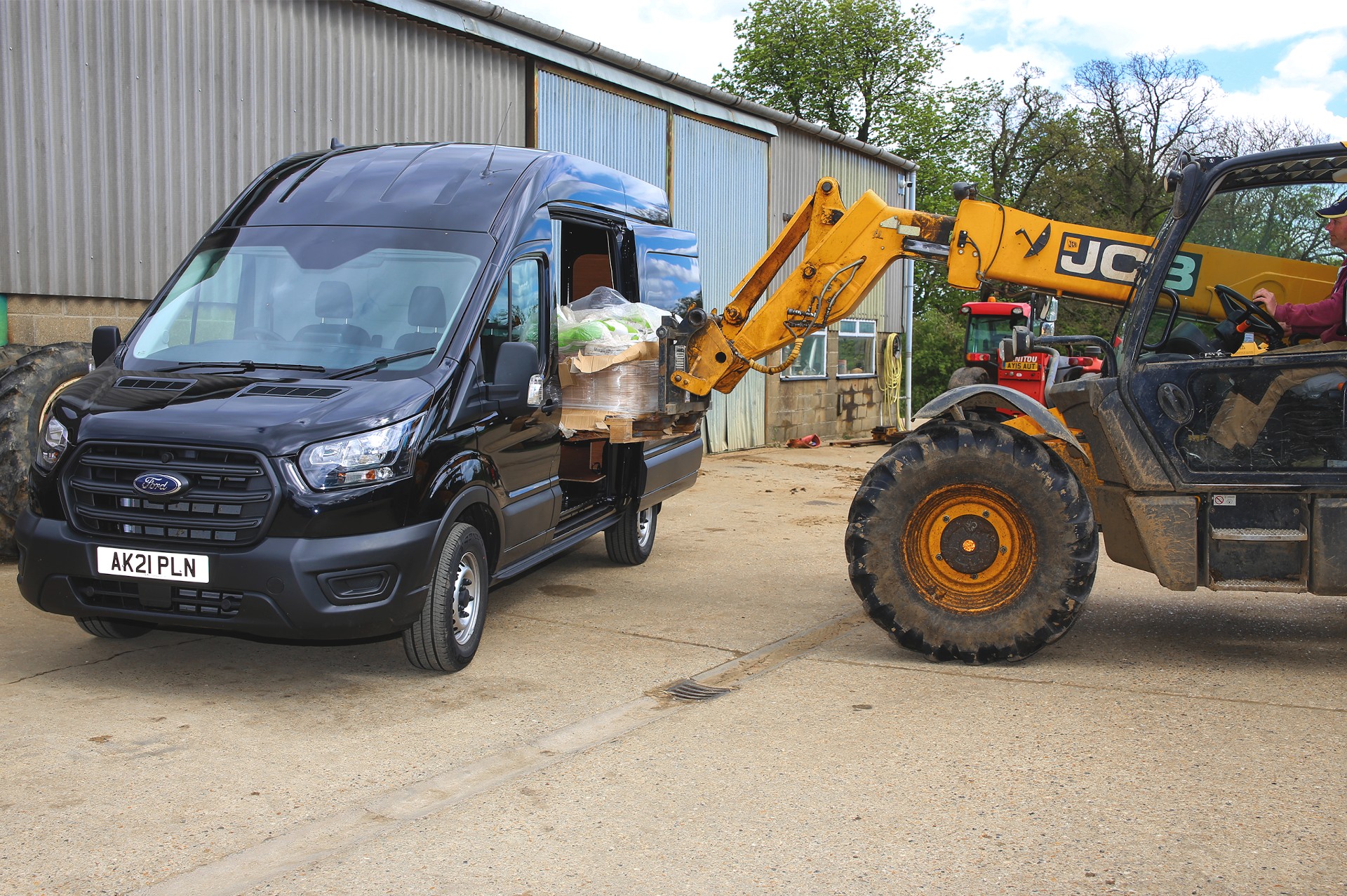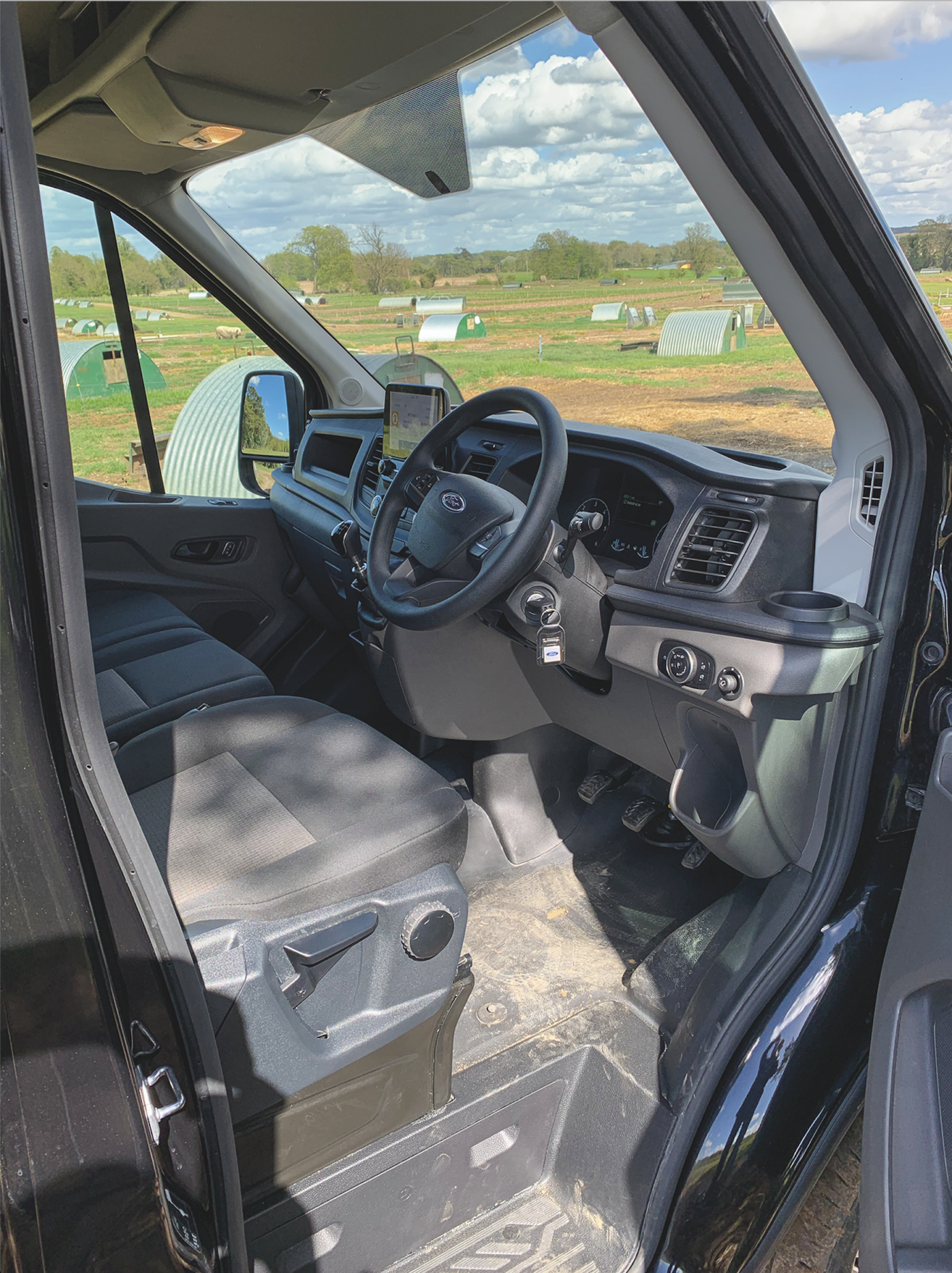All wheel drive makes the Transit a practical option
30th June 2021
While double-cab pick-ups are likely to remain popular for the foreseeable future, there are some farm tasks for which the extra load capacity and security of a van makes sense.
More than 55 years after the first Ford Transit vans rolled off the production line, the range now includes a huge range of models, specifications and options. For transporting pallets, boxes and sacks by road they are ideal, and popular with farm shops for collecting supplies and for local deliveries. Agricultural machinery dealers, contractors and tyre suppliers use them too, allowing service teams to travel to farms with all their tools and equipment, and with replacement parts under cover protected from weather and theft.
Off-road capability
Most vans are designed primarily for use on hard surfaces, and lack the traction and ground clearance needed for operating off-road. However, Ford’s Transit range is also available with 4wd and Farmers Guide put it through its paces during a week-long test – including long-distance road journeys, as well as travelling across fields and along challenging farm tracks.
The version supplied for the test was the Transit Leader 2.0 TDCi, 350 MWB High 130PS AWD with a recommended on-the-road price of £38,740, but extras fitted to the test vehicle increased this to £42,875. The Transit range includes three specification levels, although 4wd is only available in the base Leader spec and the top Trail spec, which also includes leather seats, automatic wipers and lights, plus air conditioning and external styling features. Engine options are both 2.0-litres, and 130hp or 170hp. Manual six-speed transmission is standard. The test vehicle supplied was a medium-wheelbase, high roof version with a maximum 3.5t gross vehicle weight, but a standard height model would be cheaper, and probably the preference for most farm situations.
The test week included several long road journeys and the performance from the 130hp engine was good. The manual gearbox had well- spaced ratios with plenty of overlap between the gears and it was easy to keep up with other traffic and overtake safely. The Leader specification was basic, but the hard-wearing fabric seats were practical and comfortable. Visibility is excellent, helped by a huge windscreen and large external mirrors which include wide angled lower sections for a clear view alongside the van.
The seats had plenty of adjustment and were supportive and comfortable.
The foot brake pedal is uncomfortably high, which means the driver has to lift his feet and then push down making smooth braking difficult. The ride was firm but comfortable and the van handled very well on all types of road. Fuel consumption on longer journeys averaged 32.5mpg.
Comfort and practicality
The main dashboard is well laid out, the instruments are clear and easy to see and it took only a short while to get used to the trip computer menus and functions.
Air conditioning isn’t included in the base specification Transit, although the loan vehicle had an optional manual system fitted. Heating and cooling performance were excellent, and it took only a few minutes to achieve a suitable temperature in the small cab.
Many tractor manufacturers could learn from the Transit’s creative storage solutions, and little space is wasted. There are handy pockets, trays and compartments of all sizes wherever you look, and the challenge at the end of the test week was ensuring no small items had been left behind as there were so many places to check.
Extremely capable
The off-road test drive followed several days of heavy rain, making it ideal for evaluating the 4wd. Standard 2wd is through the rear axle, but a button on the dashboard opens a small display by the main instruments, then pressing the button a second time allows a mud and ruts setting mode to be selected and engages the front axle too.
The AWD version has similar ground clearance to the standard Transit but offers improved traction. On a muddy farm track used daily by tractors, the Transit coped well – steering in and out of the ruts with ease. Although there is no low range, first gear allows slow speeds at high engine revs making it ideal for tackling tricky off-road sections. Second gear is also very flexible for off-road use, allowing a wide range of speeds, and overlap between the first two gears means the driver can change up and down without losing momentum.
The Transit AWD lacks substantial underbody protection, so it is far better suited to use in soft sand or mud or on slippery grass slopes rather than areas where rocks or tree stumps might pose a risk. However, during the test drive it proved extremely capable and there was never a fear of becoming stuck, even though the farm’s own 2wd van wouldn’t have been able to travel the same route.
Versatile load carrier
Although the test van had the optional high roof, the access for large items was similar to the standard Transit. The handy side door provides an opening 127cm wide and 161cm high (from the main flat floor) so it’s wide enough for a standard pallet. However, care is needed for loading by forklift as there is little clearance and the first point of contact is the vulnerable front edge of the sliding door. Access through the rear doors is good and with both fully open items up to 156cm wide and 184cm high can fit through the opening. Most of the floor area is flat although the wheel arches restrict the width to 136cm. The tie down points are superb, and far stronger than in most pick-ups.
Verdict
Compared with a standard rear wheel drive Transit Leader of similar specification to the model we tested, upgrading to 4wd adds approximately £4,210. Opting for the higher specification Trail model for £4,385 more adds extra comfort, but most farm vans will travel relatively short distances making the premium hard to justify, although higher residual values will eventually see most of the difference returned.
Ford’s Transit AWD impressed during the test drive, with its comfortable on-road performance combined with the ability to tackle muddy farm tracks and fields with ease. The fuel economy was much better than expected and the performance from the 130hp engine was good too.
For those combining farm and family transport and travelling longer journeys a twin-cab pick-up is hard to beat, but for agricultural dealers, farm shops and farm mechanics the Transit AWD is well worth a look.


